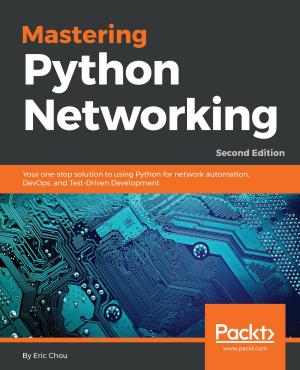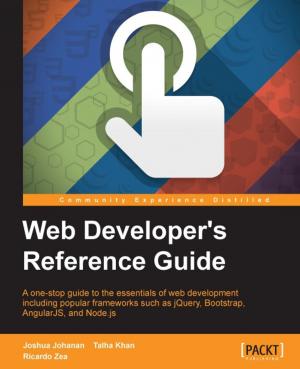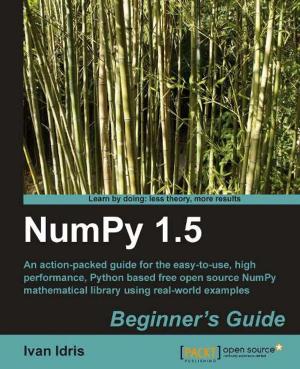Big Data Analytics with Java
Nonfiction, Computers, Internet, Web Development, Java, Programming, Application Software, Business Software| Author: | Rajat Mehta | ISBN: | 9781787282193 |
| Publisher: | Packt Publishing | Publication: | July 31, 2017 |
| Imprint: | Packt Publishing | Language: | English |
| Author: | Rajat Mehta |
| ISBN: | 9781787282193 |
| Publisher: | Packt Publishing |
| Publication: | July 31, 2017 |
| Imprint: | Packt Publishing |
| Language: | English |
Learn the basics of analytics on big data using Java, machine learning and other big data tools
About This Book
- Acquire real-world set of tools for building enterprise level data science applications
- Surpasses the barrier of other languages in data science and learn create useful object-oriented codes
- Extensive use of Java compliant big data tools like apache spark, Hadoop, etc.
Who This Book Is For
This book is for Java developers who are looking to perform data analysis in production environment. Those who wish to implement data analysis in their Big data applications will find this book helpful.
What You Will Learn
- Start from simple analytic tasks on big data
- Get into more complex tasks with predictive analytics on big data using machine learning
- Learn real time analytic tasks
- Understand the concepts with examples and case studies
- Prepare and refine data for analysis
- Create charts in order to understand the data
- See various real-world datasets
In Detail
This book covers case studies such as sentiment analysis on a tweet dataset, recommendations on a movielens dataset, customer segmentation on an ecommerce dataset, and graph analysis on actual flights dataset.
This book is an end-to-end guide to implement analytics on big data with Java. Java is the de facto language for major big data environments, including Hadoop. This book will teach you how to perform analytics on big data with production-friendly Java. This book basically divided into two sections. The first part is an introduction that will help the readers get acquainted with big data environments, whereas the second part will contain a hardcore discussion on all the concepts in analytics on big data. It will take you from data analysis and data visualization to the core concepts and advantages of machine learning, real-life usage of regression and classification using Naive Bayes, a deep discussion on the concepts of clustering,and a review of simple neural networks on big data using deepLearning4j or plain Java Spark code. This book is a must-have book for Java developers who want to start learning big data analytics and want to use it in the real world.
Style and approach
The approach of book is to deliver practical learning modules in manageable content. Each chapter is a self-contained unit of a concept in big data analytics. Book will step by step builds the competency in the area of big data analytics. Examples using real world case studies to give ideas of real applications and how to use the techniques mentioned. The examples and case studies will be shown using both theory and code.
Learn the basics of analytics on big data using Java, machine learning and other big data tools
About This Book
- Acquire real-world set of tools for building enterprise level data science applications
- Surpasses the barrier of other languages in data science and learn create useful object-oriented codes
- Extensive use of Java compliant big data tools like apache spark, Hadoop, etc.
Who This Book Is For
This book is for Java developers who are looking to perform data analysis in production environment. Those who wish to implement data analysis in their Big data applications will find this book helpful.
What You Will Learn
- Start from simple analytic tasks on big data
- Get into more complex tasks with predictive analytics on big data using machine learning
- Learn real time analytic tasks
- Understand the concepts with examples and case studies
- Prepare and refine data for analysis
- Create charts in order to understand the data
- See various real-world datasets
In Detail
This book covers case studies such as sentiment analysis on a tweet dataset, recommendations on a movielens dataset, customer segmentation on an ecommerce dataset, and graph analysis on actual flights dataset.
This book is an end-to-end guide to implement analytics on big data with Java. Java is the de facto language for major big data environments, including Hadoop. This book will teach you how to perform analytics on big data with production-friendly Java. This book basically divided into two sections. The first part is an introduction that will help the readers get acquainted with big data environments, whereas the second part will contain a hardcore discussion on all the concepts in analytics on big data. It will take you from data analysis and data visualization to the core concepts and advantages of machine learning, real-life usage of regression and classification using Naive Bayes, a deep discussion on the concepts of clustering,and a review of simple neural networks on big data using deepLearning4j or plain Java Spark code. This book is a must-have book for Java developers who want to start learning big data analytics and want to use it in the real world.
Style and approach
The approach of book is to deliver practical learning modules in manageable content. Each chapter is a self-contained unit of a concept in big data analytics. Book will step by step builds the competency in the area of big data analytics. Examples using real world case studies to give ideas of real applications and how to use the techniques mentioned. The examples and case studies will be shown using both theory and code.















